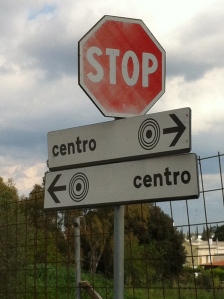We have a video of last night’s Easter Monday event in Cisternino. Local music was performed by local musicians, and local people danced local dances – quick footwork, stiff upper bodies – young and old, men with women, women with women, men with men. (I just found out you can’t put up a video on this blog, so I put the video on my Facebook page.)
Men dancing with men and women with women – does this mean that southern Italy is jollily unstressed about gender? Not necessarily.
Easter, like Pesah (Easter is Pasqua in Italian), is a festival of spring. Spring is the time of renewal, and renewal for our species means fertility and sex. Everyone knows, though not everyone tells the kids, that Easter eggs, like Easter bunnies, are about where babies come from.
Catholic ritual often unashamedly takes its impetus from a pagan foundation, like fire feeds on a bed of burned but unspent amber. Easter Monday is a fertility festival in all but name. The symbolism focuses on not only sex but also gender (to stick to a now old-fashioned distinction: sex is biological and gender social). And when it comes to gender it is hardly progressive. Frankly, some Easter rituals are a thinly disguised insult to women.
Here in parts of Puglia, people hang effigies of grotesque old women on lamp posts and balconies. Then on Easter Monday they blow them up, creating a fire works attended by crowds. No one seems to even recognize the sexism and ageism of the message: old women are useless to procreation.
It’s all really about making men more male and women more female, whatever that means in nature and culture. In Cisternino, men and women take different pastries to a nearby pilgrimage site, a twelfth century church built on the site of a pagan fertility temple. The men’s pastry is a bag with two eggs in it, the women’s a doll with one egg in the womb.
Difference, I believe, is also behind the tradition of men and women dancing separately. It may seem to outsiders as liberated gender relations, a lack of homophobia, but it isn’t.
Or better, it wasn’t. Nowadays, perhaps it is a bit of political statement, at least for the young people dancing. They search a renewal based in tradition. Like, one hopes, the new guy in the Vatican does, too.


